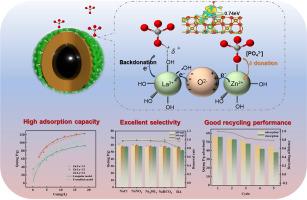界面电子重分配允许在负载Zn/ la的磁性介孔纳米球中进行高级磷酸盐吸附
IF 12.4
1区 环境科学与生态学
Q1 ENGINEERING, ENVIRONMENTAL
引用次数: 0
摘要
我们通过蚀刻和共沉积技术成功构建了一种核壳结构的Zn/La磁性介孔二氧化硅(简称Zn/La- mms)复合材料,实现了对磷酸盐的高效吸附。在Zn/La比为0.5(即Zn/La-0.5 MMS)的优化条件下,复合材料具有有序的介孔结构和优异的吸附性能,最大吸附量为140.9 mg P/g(比原始MMS高15倍)。在较宽的pH范围(3 ~ 11)和大量共存离子/物质(Cl−、NO3−、SO42−、HCO3−和腐植酸,浓度为PO43−-P浓度的20 ~ 50倍)存在的情况下,取得了较高的吸附性能。经过5次吸附-再生循环后,吸附量保持在79%,磁选回收率为95%。通过x射线吸收精细结构表征和密度泛函理论(DFT)计算揭示了双金属协同机理。La和Zn之间的电负性差异引起了界面电子的重新分配,促使电子从La/Zn-O杂化轨道回给到HPO₄²的O 2p反键轨道,形成稳定的共价配位键(La-O- p /Zn-O- p),从而使得磷酸盐的吸附非常高效。这一现象有望对新型磷酸盐深度去除吸附材料的开发产生重要影响。本文章由计算机程序翻译,如有差异,请以英文原文为准。

Interfacial electron redistribution allows advanced phosphate adsorption in Zn/La-loaded magnetic mesoporous nanospheres
A core-shell structured Zn/La magnetic mesoporous silica (denoted as Zn/La-MMS) composite we successfully constructed via etching and co-deposition techniques, achieving exceptionally efficient adsorption of phosphate. At an optimized Zn/La ratio of 0.5 (i.e., Zn/La-0.5 MMS), the composite exhibited an ordered mesoporous structure and superior adsorption performance with a maximum phosphate adsorption capacity of 140.9 mg P/g (15-fold higher than the pristine MMS). High adsorption performance was achieved across a broad pH range of 3 to 11 and in the presence of substantial amounts of co-existing ions/substances (Cl−, NO3−, SO42−, HCO3−, and humic acid at concentrations 20-50 times that of the PO43−-P concentration). After five adsorption-regeneration cycles, 79% adsorption capacity remained with material recovery rates >95% via magnetic separation. A bimetallic synergistic mechanism was revealed via X-ray absorption fine-structure characterizations and density functional theory (DFT) calculations. The electronegativity difference between La and Zn induces interfacial electron redistribution, driving electron back-donation from the La/Zn-O hybridized orbitals to the O 2p antibonding orbitals of HPO₄²⁻, forming stable covalent coordination bonds (La-O-P/Zn-O-P), which allowed the exceptionally high and efficient adsorption of phosphate. This phenomenon is expected to have important implications for the development of novel adsorption materials for advanced removal of phosphate.
求助全文
通过发布文献求助,成功后即可免费获取论文全文。
去求助
来源期刊

Water Research
环境科学-工程:环境
CiteScore
20.80
自引率
9.40%
发文量
1307
审稿时长
38 days
期刊介绍:
Water Research, along with its open access companion journal Water Research X, serves as a platform for publishing original research papers covering various aspects of the science and technology related to the anthropogenic water cycle, water quality, and its management worldwide. The audience targeted by the journal comprises biologists, chemical engineers, chemists, civil engineers, environmental engineers, limnologists, and microbiologists. The scope of the journal include:
•Treatment processes for water and wastewaters (municipal, agricultural, industrial, and on-site treatment), including resource recovery and residuals management;
•Urban hydrology including sewer systems, stormwater management, and green infrastructure;
•Drinking water treatment and distribution;
•Potable and non-potable water reuse;
•Sanitation, public health, and risk assessment;
•Anaerobic digestion, solid and hazardous waste management, including source characterization and the effects and control of leachates and gaseous emissions;
•Contaminants (chemical, microbial, anthropogenic particles such as nanoparticles or microplastics) and related water quality sensing, monitoring, fate, and assessment;
•Anthropogenic impacts on inland, tidal, coastal and urban waters, focusing on surface and ground waters, and point and non-point sources of pollution;
•Environmental restoration, linked to surface water, groundwater and groundwater remediation;
•Analysis of the interfaces between sediments and water, and between water and atmosphere, focusing specifically on anthropogenic impacts;
•Mathematical modelling, systems analysis, machine learning, and beneficial use of big data related to the anthropogenic water cycle;
•Socio-economic, policy, and regulations studies.
 求助内容:
求助内容: 应助结果提醒方式:
应助结果提醒方式:


